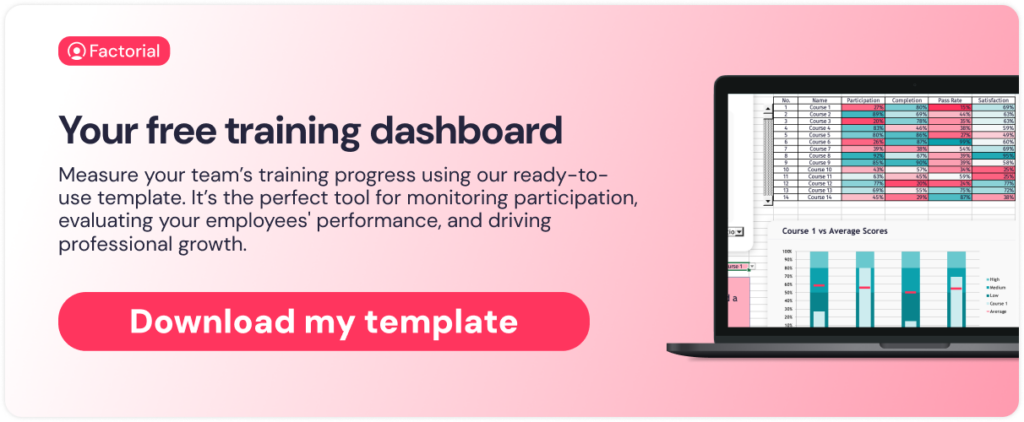Learning and development (L&D), also known as training and development, is a core function of human resource management. L&D is typically organised by HR or senior leaders who want to empower their teams and offer professional development opportunities. When managed well, it can help your team develop new skills and knowledge, resulting in improved performance. Having a robust policy in place is also a great way to attract the right talent to your company.
This article is a guide to learning and development for employers. Training and development programmes provide a wide range of courses such as compliance trainings to upskilling opportunities. We will break down L&D meaning and what you need to consider when you design your strategy. We will also look at the benefits of implementing an effective L&D policy in your company.
What is Learning and Development?
L&D has become an integral part of most business strategies. At its heart, it is a systematic process designed to improve and develop employees skills, competencies and knowledge for the good of the company. An effective L&D strategy also aims to cultivate a culture of shared learning and motivates employees to perform better.
Let’s start with a couple of basic definitions:
Learning: The acquisition of knowledge and skills through experience, study, or teaching. Short-term focus.
Development: The broadening or deepening of knowledge in line with the goals of both the individual and the organisation. Long-term focus.
Learning and Development Definition
Learning and development is ultimately about creating a culture in your organisation where employees are able to learn and develop new skills. It involves analysing the needs of your company to identify learning opportunities, and designing and implementing development programs to drive continuous growth. Learning approaches often used by companies include face-to-face training, collaborative learning, and online development.
L&D usually forms a part of a company’s talent management strategy, the aim of which is to attract, acquire, nurture and retain quality employees. Companies that take the time to analyse training needs and implement strategies to address those needs are better equipped to drive employee engagement and continuous professional development. They are also more likely to achieve increased business performance and grow as a company.
The Benefits of Learning and Development
- Performance: the more skills and experience an employee has, the better they will perform. Improved business performance is usually the top objective of every learning and development strategy.
- Talent acquisition: having an effective L&D strategy in place makes you more attractive to potential hires. It also increases retention rates and decreases turnover.
- Skill development: your company is as good as your employees. The more skills they have, the more you will have to offer as a business.
- Engagement: studies have shown that companies with a strong culture of continuous development are more likely to have engaged employees. This is especially true for younger generations who place more value on learning in the workplace.
- Reputation and brand: a company that invests in the development of its employees is more likely to have a solid reputation and brand. Corporate giants such as Google and Amazon are very vocal about their “learning-focused” approach. This helps them stand out as an “employer of choice” and attracts quality talent to the workforce.
- Growth: the process of identifying training gaps in your company will help you address any weak areas in your company. This will improve overall performance and help you grow as a company.
Learning and Development strategies
In most companies, Learning and Development strategies are managed by Human Resources. The HR department evaluates employee skills, identifies training needs, designs learning and development training plans and monitors individual progress against defined KPIs.
As an HR manager, the first step is to design and implement an effective strategy that takes into account all stages of the learning and development cycle:
- Talent gap analysis: evaluate the skills of employees and identify training needs. Focus on skills and knowledge that are relevant to each position in order to create new business capabilities. Perform assessments and gather employee feedback to identify areas for improvement and potential development opportunities in line with business objectives.
- Design L&D strategy: translate your identified training needs into measurable learning objectives (e.g. junior accountant Brian needs to obtain the ICAEW Chartered Accountant qualification by September 2022). This will help you define training content and areas.
- Define training content and methods: decide how training will be imparted (hands-on training, online or offline learning and development courses, executive coaching, etc.). This will depend on training needs. If you are going to outsource training then decide which external partner you will work with consultants, coaching organisations, etc. If you are managing training internally, design training materials, teaching methods and learning activities. This might include seminars, presentations, case studies, role-playing activities, and on-the-job training.
- Execution: implement your L&D strategy. Consider using digital tools to create flexible and innovative learning programmes.
- Monitor and review: monitor how effectively learning has been transferred to employees. Evaluate if training KPIs have been met. Assess the impact on performance. Bloom’s taxonomy is a great model for evaluating learning effectiveness. Use the results to modify your next learning cycle.

Methods of Training
There are various ways in which HR or people teams can approach training in the workplace. And its of the utmost importance that the employees and trainees obtain as much information as possible. Therefore, in order to help employees retain what they are being taught, employers must provide rich and engaging learning opportunities for their staff.
We’ve gathered a selection of the most effective employee training methods in the workplace:
- Onboarding – First up, this method of learning is for new employees, enabling them to get a better understanding of the company.
- Coaching – This method is used to comprehensively train new employees on the duties of their role through a 1-1 approach and can be conducted by a manager or team member.
- Hands-on training – This is an engaging learning approach, employees are able to retain more information through “learning by doing”.
- Lectures/Conferences – The lecture-based methodology is one of the simplest and oldest training techniques. It is used to share knowledge and provide an introduction to a specific topic to a wider audience of employees.
- Group discussion and activities – This is a collaborative workplace training method, allowing multiple employees to discuss certain topics and train simultaneously.
- Role-play – This is an active learning technique, where employees act out scenarios under the guidance of a trainer or facilitator.
- Online training & eLearning – This method of training is completed through online videos, tests, and courses. This is one of the easiest types of training in the workplace, as it requires minimal effort from the employer.
These are a handful of the common methods of workplace learning and of course, there are many more training methods out there. But the most important thing is that HR teams choose the right workplace training method to engage their team. It’s important to review your company’s training and development material to ensure they are up to date with the most relevant information.

Learning & Development in Larger Companies
Generally speaking, the larger the company, the more extensive the learning and development policy will be. For one thing, larger companies have more money to invest in developing skills. Opportunities are likely to be more formal and structured, and training programmes are more likely to be delivered by external providers. More established companies also tend to have larger executive boards so they are more likely to focus on senior management coaching and leadership training.
By designing and implementing extensive learning and development programmes, larger corporations are able to boost their reputation and enhance their corporate brand. They are viewed as supportive employers that nurture the career development needs of their employees, which helps attract and retain talent. In larger businesses, the HR department tends to create a more robust L&D policy that provides opportunities for a diverse set of skills.
L&D in Smaller Corporations
Smaller companies have a few more restraints when it comes to staff training, the most notable being budget. As small and medium enterprises have fewer resources to invest in learning opportunities, L&D tends to be less formal and structured. There is more of a focus on ‘on-the-job training’ and on building a culture of continuous learning. The result of this is that employees tend to be more self-motivated rather than following a pre-designed roadmap.
Social learning is used a lot by smaller companies. This is a form of continuous learning where employees learn skills through experience and watching their colleagues. It can often lead to faster career development compared to the more formal structures used by larger companies. L&D policies should be used in small and medium-sized businesses, regardless of their limited resources. These businesses can still benefit from their team’s growth and skills.
If you are a smaller company then you might consider rolling out personal development plans for all your employees. These outline an employee’s strengths and weaknesses, identify training requirements and establish measurable goals for learning and development. Pairing employees with mentors is another great way of developing this concept. Above all, remember that L&D is an ongoing process and should be integrated with everyday workflows. It is also vital that you implement a strategy for continuous performance management so that you can measure the effectiveness of your training strategy.



